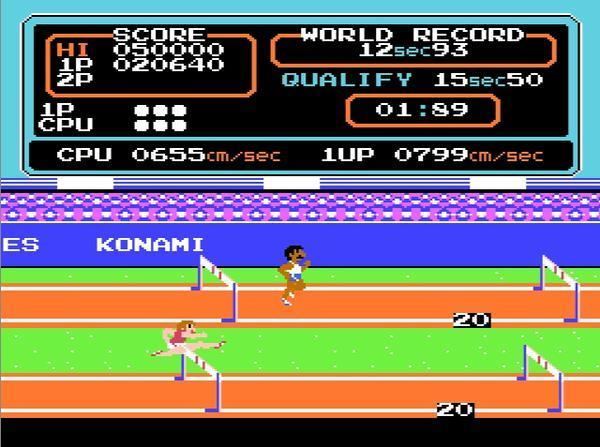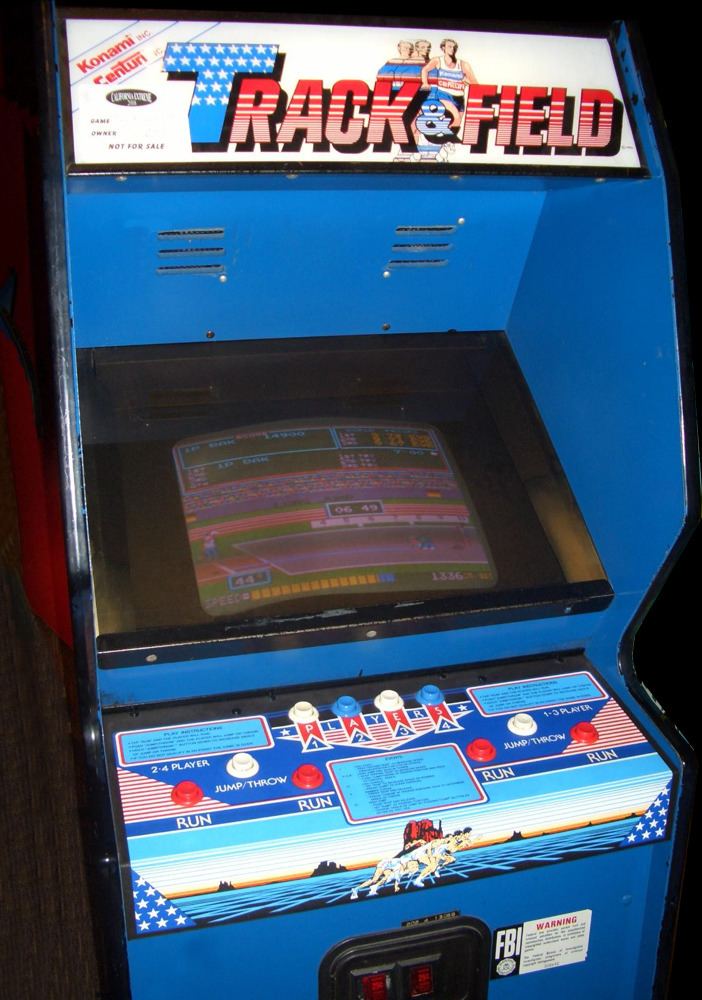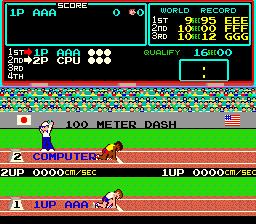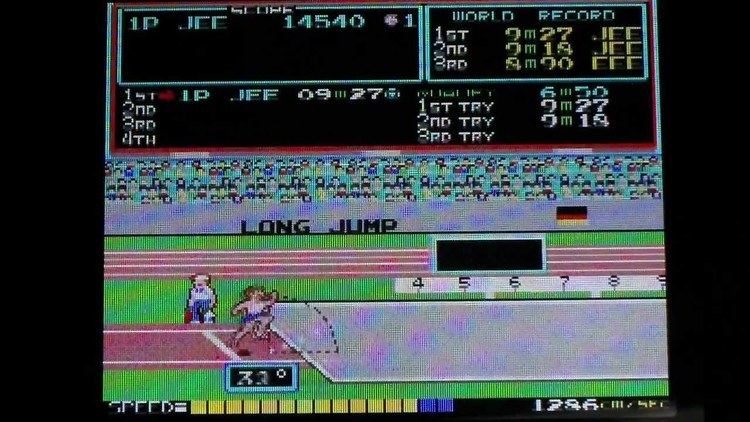Cabinet Upright Initial release date September 1983 Genre Sports game | Sound Mono | |
 | ||
Mode(s) Single-player, two players simultaneouslyFour players total Display Raster, Horizontal orientation, 256 × 224 resolution Similar Konami games, Track and field athletics games, Other games | ||
Track & Field, known in Japan as Hyper Olympic (ハイパーオリンピック, Haipā Orinpikku), is a 1983 Olympic-themed sports arcade game developed and published by Konami. The Japanese release sported an official license for the 1984 Summer Olympics.
Contents

The arcade version was released in 1983. The simple gameplay, based on quick repeating button presses, set the basics for sequels and similar games in the genre for the next decades. There were several home versions of the original; the ZX Spectrum and Amstrad CPC versions were only released as part of the Game, Set and Match II compilation in 1988, and are poorly regarded by fans. The NES version was especially well-received, and sold well.

Gameplay

In the original arcade game, the player uses two "run" buttons (or a trackball in later units that replaced buttons damaged from overuse) and one "action" button to control an athlete competing in the following six events:


In each event, there is a qualifying time or level that the player must achieve to advance to the next event; failing to qualify (in one heat for running events or three tries in the other events) will reduce the player's number of lives by one, but if none are present in his/her disposal, the game will end. Players earn extra lives per 100,000 points scored.

The game can accommodate up to four players, who compete in pairs for the running events, and individually for the others. If there are fewer than four players, the remaining slots are played by the computer (or player "CPU"). In all multiplayer heats, though, the relative performance of the players has no effect on the game, and advancing is based solely on qualifying times. While most multiplayer arcade games had each set of controls relative to the players going from left to right, this game (which has two sets of controls) had a somewhat different setup. The left set of controls were for players 2 and 4, while the right set was for players 1 and 3. This is one of the few classic arcade games where single player mode was played on the right set of controls rather than the left. If a player completes all six events after a brief medal ceremony, he or she is sent back to the field for another round, with higher qualifying levels, however the game can be configured to conclude after the final event.
Because the game responded to repeatedly pressing the "run" buttons at high frequency, players of the arcade version resorted to various tricks such as rapidly swiping a coin or ping-pong ball over the buttons, or using a metal ruler which was repeated struck such that it would vibrate and press the buttons. As a result, arcade operators reported high rates of damage to the buttons and later versions had modifications to prevent such actions.
Reception
The game sold 38,000 arcade hardware units in Japan by the end of 1983. It was also a hit in North America.
AllGame gave the game three stars out of five, calling it "a physically exhausting game that invented a new genre" and "In addition to challenging events and pure originality, Track & Field offers nice (if cartoonish) graphics, rich colors, smooth animation and a terrific rendition of the theme from Chariots of Fire."
Legacy
Konami continued releasing games on the series:
In the follow-up Hyper Sports, there were seven events: 100-meter freestyle, skeet shooting, vault, archery, triple jump, weight lifting and pole vault.
Ports and re-releases
Track & Field was initially ported by Atari, Inc. to the Atari 2600 console and the Atari 8-bit computers, and under the Atarisoft label also for the Apple II and the Commodore 64. A port for the Atari 5200, identical to the Atari 8-bit computer version, was being developed in 1984, but was cancelled.
When Konami ported their arcade hit Track & Field to the Famicom (as Hyper Olympic), they only included four out of six events. Afterwards, they converted Hyper Sports to the Famicom as well, this time including three of the Hyper Sports events and one more event from Track & Field. By the time the NES gained popularity in the United States, Konami retooled the game for release in America by including all eight events from both games in one cartridge. Of the original six events from Track & Field, only the hammer throw is missing; in its place, however, are skeet shooting, archery, and triple jump.
The NES version of Track & Field was re-released in Europe in 1992 as Track & Field in Barcelona by Kemco in the light of the 1992 Summer Olympics. The opening song for the NES version is the Chariots of Fire theme by Vangelis (which was also used in the arcade version's high score screen). The Game Boy version was also re-released as part of the Konami GB Collection series.
The Xbox Live Arcade version of the game was released on the Xbox 360 on August 8, 2007. It features updated graphics and sounds, leaderboards, and online play over the Xbox Live service. The game also appears in Konami Classics Series: Arcade Hits for the Nintendo DS, but with an altered version of the Chariots of Fire theme.
Competition
On December 18, 2008, Hector Rodriguez, of California, USA, scored a world record 95,350 points on the classic arcade game Track & Field. Rodriguez beat the 23-year-old record of 95,040 points set on June 30, 1985 by Kelly Kobashigawa, of Los Angeles, during Twin Galaxies' 1985 Video Game Masters Tournament in Victoria, British Columbia, Canada.
The Twin Galaxies' Official Video Game & Pinball Book of World Records - Arcade Volume, lists history's largest video game contest as the "1984 March of Dimes International Konami/Centuri Track & Field Challenge". The editors say: "More than 1 million contestants played Track & Field between April 30 and May 26, hoping to be among three finalists going to Japan to represent the USA. As a fundraiser for the March of Dimes, the event was held in Aladdin's Castle arcades and National Convenience Stores. Gary West of Oklahoma City won the U.S. Finals, but Phil Britt, of Riverside, California, won the World Championship in Tokyo on June 10, 1984."
